英语诗歌中修辞手法的艺术效果之欣赏――以《西风颂》为例.
- 格式:doc
- 大小:223.00 KB
- 文档页数:3
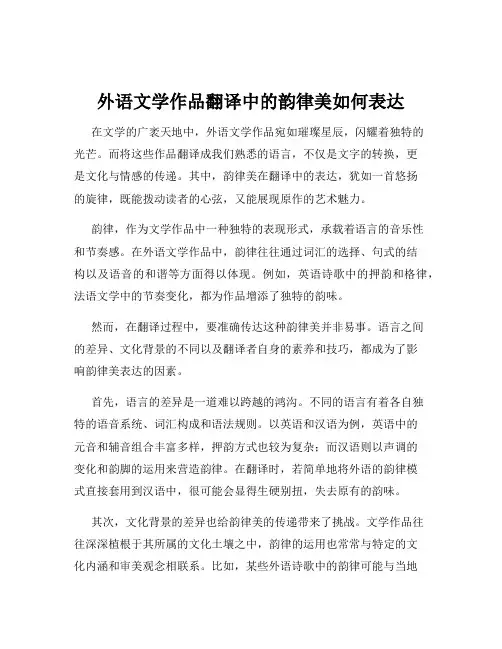
外语文学作品翻译中的韵律美如何表达在文学的广袤天地中,外语文学作品宛如璀璨星辰,闪耀着独特的光芒。
而将这些作品翻译成我们熟悉的语言,不仅是文字的转换,更是文化与情感的传递。
其中,韵律美在翻译中的表达,犹如一首悠扬的旋律,既能拨动读者的心弦,又能展现原作的艺术魅力。
韵律,作为文学作品中一种独特的表现形式,承载着语言的音乐性和节奏感。
在外语文学作品中,韵律往往通过词汇的选择、句式的结构以及语音的和谐等方面得以体现。
例如,英语诗歌中的押韵和格律,法语文学中的节奏变化,都为作品增添了独特的韵味。
然而,在翻译过程中,要准确传达这种韵律美并非易事。
语言之间的差异、文化背景的不同以及翻译者自身的素养和技巧,都成为了影响韵律美表达的因素。
首先,语言的差异是一道难以跨越的鸿沟。
不同的语言有着各自独特的语音系统、词汇构成和语法规则。
以英语和汉语为例,英语中的元音和辅音组合丰富多样,押韵方式也较为复杂;而汉语则以声调的变化和韵脚的运用来营造韵律。
在翻译时,若简单地将外语的韵律模式直接套用到汉语中,很可能会显得生硬别扭,失去原有的韵味。
其次,文化背景的差异也给韵律美的传递带来了挑战。
文学作品往往深深植根于其所属的文化土壤之中,韵律的运用也常常与特定的文化内涵和审美观念相联系。
比如,某些外语诗歌中的韵律可能与当地的宗教信仰、历史传统或民间习俗相关。
如果翻译者对这些文化背景缺乏了解,就难以准确把握韵律背后的深层含义,从而无法完美地传达出其中的韵律美。
那么,在面对这些困难时,翻译者应该如何努力去表达外语文学作品中的韵律美呢?其一,翻译者需要深入理解原作的韵律特点和艺术风格。
这要求翻译者不仅要精通外语,还要具备敏锐的文学感知力,能够细腻地体会原作中韵律所产生的情感共鸣和艺术效果。
通过反复研读原作,分析其中的韵律模式、节奏变化以及与内容的融合方式,从而为翻译工作打下坚实的基础。
其二,翻译者要在汉语中寻找与之相契合的韵律表达方式。

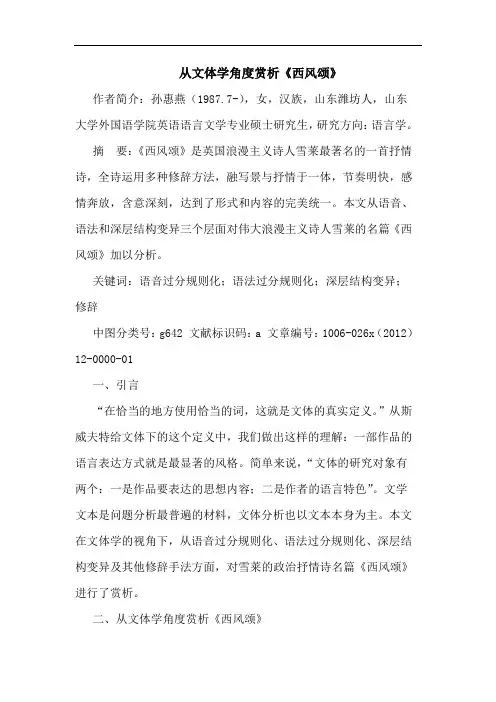
从文体学角度赏析《西风颂》作者简介:孙惠燕(1987.7-),女,汉族,山东潍坊人,山东大学外国语学院英语语言文学专业硕士研究生,研究方向:语言学。
摘要:《西风颂》是英国浪漫主义诗人雪莱最著名的一首抒情诗,全诗运用多种修辞方法,融写景与抒情于一体,节奏明快,感情奔放,含意深刻,达到了形式和内容的完美统一。
本文从语音、语法和深层结构变异三个层面对伟大浪漫主义诗人雪莱的名篇《西风颂》加以分析。
关键词:语音过分规则化;语法过分规则化;深层结构变异;修辞中图分类号:g642 文献标识码:a 文章编号:1006-026x(2012)12-0000-01一、引言“在恰当的地方使用恰当的词,这就是文体的真实定义。
”从斯威夫特给文体下的这个定义中,我们做出这样的理解:一部作品的语言表达方式就是最显著的风格。
简单来说,“文体的研究对象有两个:一是作品要表达的思想内容;二是作者的语言特色”。
文学文本是问题分析最普遍的材料,文体分析也以文本本身为主。
本文在文体学的视角下,从语音过分规则化、语法过分规则化、深层结构变异及其他修辞手法方面,对雪莱的政治抒情诗名篇《西风颂》进行了赏析。
二、从文体学角度赏析《西风颂》(一)语音过分规则化诗歌讲究语言的乐感,分析诗歌时,语音始终是一个重要的衡量标准。
《西风颂》的格律是但丁《神曲》所用的三行诗节(terzerima)与莎士比亚的十四行诗(sonnet)的完美结合。
诗人使用跨行跨节诗行(run-online),前四节为三行诗,第v节为双行排偶句(couplet),既遵守了十四行诗体,又富于变化。
在音韵上,诗人采用了独特的环环相扣的韵脚:aba,bab,cdc,ded,ee,而在诗行中则采用五步抑扬格,以及其独特的重读单音节押阳韵等方法。
诗的节奏感强,同时全诗五章格律一致,通篇成为衔接紧密的一个整体。
在“ode to the west wind”中,west与wind运用了押头韵的形式。
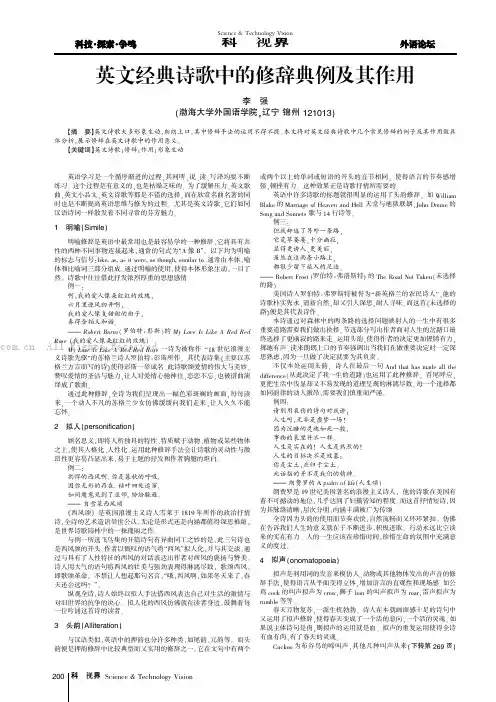
Science &Technology Vision科技视界英语学习是一个循序渐进的过程,其间听、说、读、写译均要不断练习。
这个过程是有意义的,也是枯燥乏味的。
为了缓解压力,英文歌曲,英文小品文,英文诗歌等都是不错的选择。
而在欣赏名曲名著的同时也是不断提高英语思维与修为的过程。
尤其是英文诗歌,它们如同汉语诗词一样散发着不同寻常的芬芳魅力。
1明喻(Simile)明喻修辞是英语中最常用也是最容易学的一种修辞,它将具有共性的两种不同事物连接起来,通常的句式为“A 像B”。
以下均为明喻的标志与信号:like,as,as it were,as though,similar to。
通常由本体,喻体和比喻词三部分组成。
通过明喻的使用,使得本体形象生动,一目了然。
诗歌中往往借此抒发浓烈厚重的思想感情。
例一:啊,我的爱人像朵红红的玫瑰,六月里迎风初开啊,我的爱人像支甜甜的曲子,奏得合拍又和谐。
———Robert Burns (罗伯特·彭斯)的My Love Is Like A Red Red Rose (我的爱人像朵红红的玫瑰)My Love Is Like A Red Red Rose 一诗为被称作“18世纪浪漫主义诗歌先驱”的苏格兰诗人罗伯特·彭斯所作。
其代表诗集《主要以苏格兰方言而写的诗》使得彭斯一举成名。
此诗歌颂爱情的伟大与美妙,赞叹爱情的圣洁与魅力,让人对爱情心驰神往,恋恋不忘。
也被谱曲演绎成了歌曲。
通过此种修辞,全诗为我们呈现出一幅色彩斑斓的画面,每每读来,一个动人不凡的苏格兰少女仿佛缓缓向我们走来,让人久久不能忘怀。
2拟人(personification)顾名思义,即将人所独具的特性、特质赋于动物、植物或某些物体之上,使其人格化、人性化。
运用此种修辞手法会让诗歌的灵动性与激昂性更容易凸显出来,易于主题的抒发和作者胸臆的坦白。
例二:剽悍的西风啊,你是暮秋的呼吸,因你无形的存在,枯叶四处逃窜,如同魔鬼见到了巫师,纷纷躲避。
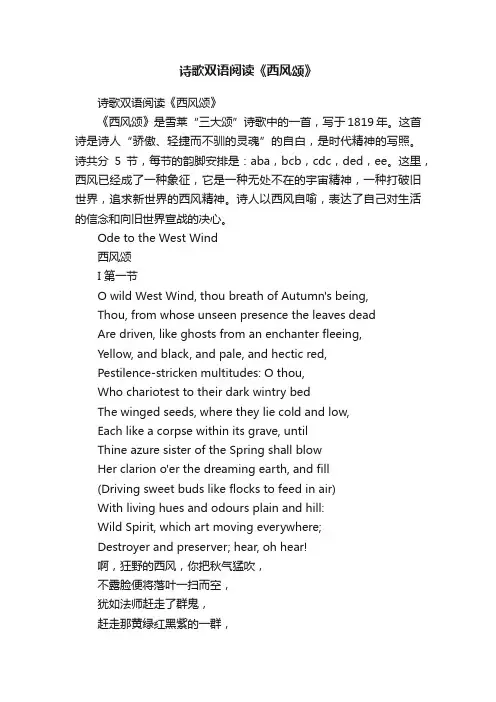
诗歌双语阅读《西风颂》诗歌双语阅读《西风颂》《西风颂》是雪莱“三大颂”诗歌中的一首,写于1819年。
这首诗是诗人“骄傲、轻捷而不驯的灵魂”的自白,是时代精神的写照。
诗共分5节,每节的韵脚安排是:aba,bcb,cdc,ded,ee。
这里,西风已经成了一种象征,它是一种无处不在的宇宙精神,一种打破旧世界,追求新世界的西风精神。
诗人以西风自喻,表达了自己对生活的信念和向旧世界宣战的决心。
Ode to the West Wind西风颂I 第一节O wild West Wind, thou breath of Autumn's being,Thou, from whose unseen presence the leaves deadAre driven, like ghosts from an enchanter fleeing,Yellow, and black, and pale, and hectic red,Pestilence-stricken multitudes: O thou,Who chariotest to their dark wintry bedThe winged seeds, where they lie cold and low,Each like a corpse within its grave, untilThine azure sister of the Spring shall blowHer clarion o'er the dreaming earth, and fill(Driving sweet buds like flocks to feed in air)With living hues and odours plain and hill:Wild Spirit, which art moving everywhere;Destroyer and preserver; hear, oh hear!啊,狂野的西风,你把秋气猛吹,不露脸便将落叶一扫而空,犹如法师赶走了群鬼,赶走那黄绿红黑紫的一群,那些染上了瘟疫的魔怪——呵,你让种子长翅腾空,又落在冰冷的土壤里深埋,象尸体躺在坟墓,但一朝你那青色的`东风妹妹回来,为沉睡的大地吹响银号,驱使羊群般蓓蕾把大气猛喝,就吹出遍野嫩色,处处香飘。

英语诗歌赏析:西风颂雪莱英语诗歌赏析:西风颂雪莱在学习、工作、生活中,大家都收藏过令自己印象深刻的诗歌吧,诗歌的内容是社会生活的`最集中的反映。
还在苦苦寻找优秀经典的诗歌吗?以下是小编收集整理的英语诗歌赏析:西风颂雪莱,仅供参考,大家一起来看看吧。
Ode to the West wind西风颂雪莱If I were a dead leaf thou mightest bear;If I were a swift cloud to fly with thee;A wave to pant beneath thy power,and share.The impulse of thy strength,only less freeThan thou,O,uncontrollable!If evenI were as in my boyhood,and could beThe comrade of thy wanderings over heaven,As then,when to outstrip thy skiey speedScarce seemed a vision;I would neer have strivenAs thus with thee in prayer in my sore need .Oh,lift me as a wave,a leaf,a cloud!I fall upon the thorns of life!I bleed!A heavy weight of hours has chained and bowed.One too like thee:tameless,and swift ,and proudMake me thy lyre,even as the forest is:What if my leaves are falling like its own!The tumult of thy mightly harmoniesWill take from both a deep,autumnal tone,Sweet though in sadness.Be thou,spixit fierce,My spirit!Be thou me,impetuous one!Drive my dead thoughts over the universeLike withered leaves to quicken a new birth! And,by the incantation of this verse, Scatter,as from an unextinguished hearth Ashes and sparks,my words among mankind! Be through my lips to unawakened earth. The trumpet of a phophecy!O wind,If winter comes ,can spring be far behind?。
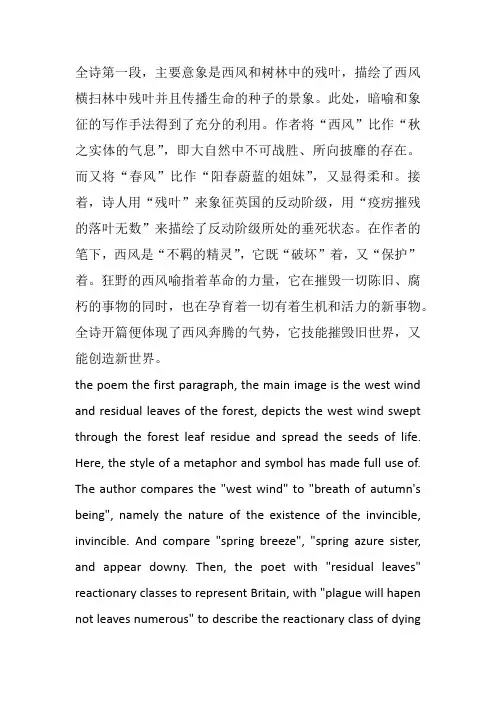
全诗第一段,主要意象是西风和树林中的残叶,描绘了西风横扫林中残叶并且传播生命的种子的景象。
此处,暗喻和象征的写作手法得到了充分的利用。
作者将“西风”比作“秋之实体的气息”,即大自然中不可战胜、所向披靡的存在。
而又将“春风”比作“阳春蔚蓝的姐妹”,又显得柔和。
接着,诗人用“残叶”来象征英国的反动阶级,用“疫疠摧残的落叶无数”来描绘了反动阶级所处的垂死状态。
在作者的笔下,西风是“不羁的精灵”,它既“破坏”着,又“保护”着。
狂野的西风喻指着革命的力量,它在摧毁一切陈旧、腐朽的事物的同时,也在孕育着一切有着生机和活力的新事物。
全诗开篇便体现了西风奔腾的气势,它技能摧毁旧世界,又能创造新世界。
the poem the first paragraph, the main image is the west wind and residual leaves of the forest, depicts the west wind swept through the forest leaf residue and spread the seeds of life. Here, the style of a metaphor and symbol has made full use of. The author compares the "west wind" to "breath of autumn's being", namely the nature of the existence of the invincible, invincible. And compare "spring breeze", "spring azure sister, and appear downy. Then, the poet with "residual leaves" reactionary classes to represent Britain, with "plague will hapen not leaves numerous" to describe the reactionary class of dyingstate. In the author's works, the west wind is the "spirit", it is "destruction", and "protection". Wild west wind yu pointed to the revolutionary force, it in destroying everything全诗第二段,雪莱进一步运用了天空中的云、雨和电等意象来描绘了西风在长空中的磅礴气势。
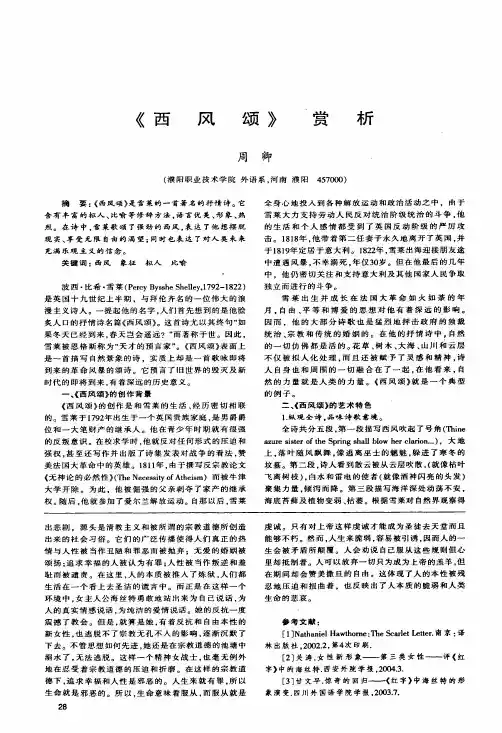
《西风颂》周卿-皆罗j(濮阳职业技术学院外语系,河南濮阳457000)摘要:《西风颂》是雪莱的一首著名的抒情诗。
它含有丰富的拟人、比喻等修辞方法,语言优美、形象、热烈。
在诗中,雪莱歌颂了强劲的西风。
表达了他想摆脱现实、享受无限自由的渴望:同时也表达了对人类未来充满乐观主义的信念。
关键词:西风象征拟人比喻波西比希雪莱(Per cy B y s s h e S hel l e y。
1792—1822)是英国十九世纪上半期。
与拜伦齐名的一位伟大的浪漫主义诗人。
一提起他的名字。
人们首先想到的是他脍炙人口的抒情诗名篇《西风颂》。
这首诗尤以其终句“如果冬天已经到来,春天岂会遥远?”而著称于世。
因此。
雪莱被恩格斯称为“天才的预言家”。
《西风颂》表面上是一首描写自然景象的诗.实质上却是一首歌咏即将到来的革命风暴的颂诗。
它预言了旧世界的毁灭及新时代的即将到来。
有着深远的历史意义。
一、《西风颂》的创作背景《西风颂》的创作是和雪莱的生活、经历密切相联的。
雪莱于1792年出生于一个英国贵族家庭.是男爵爵位和一大笔财产的继承人。
他在青少年时期就有很强的反叛意识。
在校求学时。
他就反对任何形式的压迫和强权,甚至还写作并出版了诗集发表对战争的看法.赞美法国大革命中的英雄。
1811年.由于撰写反宗教论文《无神论的必然性)(T h e N ec es si t y of A t l l ei sm)而被牛津大学开除。
为此,他被倔强的父亲剥夺了家产的继承权。
随后,他就参加了爱尔兰解放运动。
自那以后,雪莱析全身心地投入到各种解放运动和政治活动之中,由于雪莱大力支持劳动人民反对统治阶级统治的斗争。
他的生活和个人感情都受到了英国反动阶级的严厉攻击。
1818年,他带着第二任妻子永久地离开了英国。
并于1819年定居于意大利。
1822年,雪莱出海迎接朋友途中遭遇风暴,不幸溺死。
年仅30岁。
但在他最后的几年中.他仍密切关注和支持意大利及其他国家人民争取独立而进行的斗争。
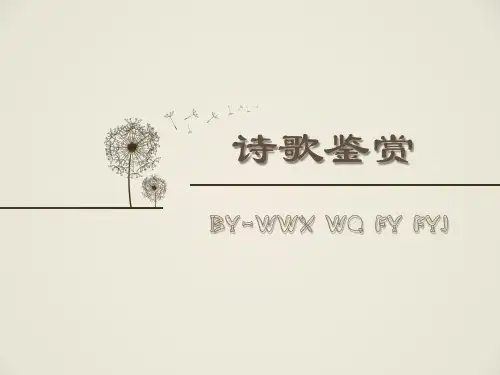
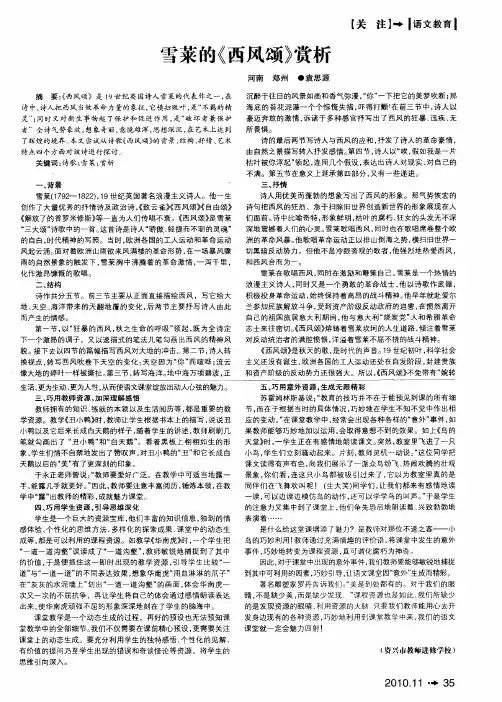
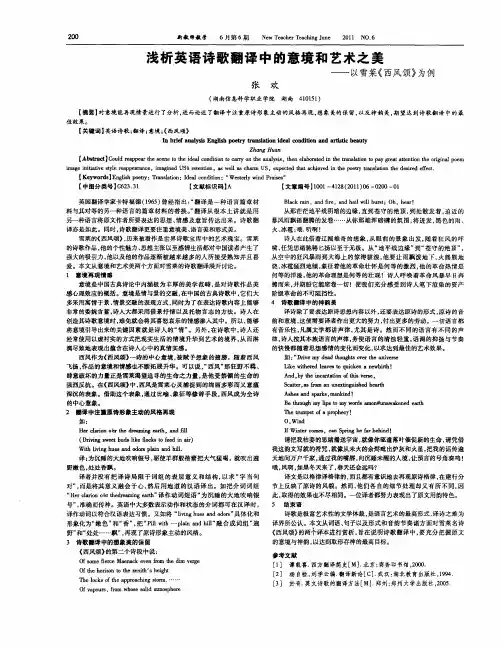
从英语诗歌语言艺术风格角度赏析《西风颂》
《西风颂》是中国古典诗歌中著名的山水类诗歌,作者是清代名家唐琬。
文中
用以抒发作者关于西风的深深崇拜之情,令人难以忘怀。
从文章的艺术风格来看,作者采用了极其高雅的文字,语言气质生动,充满恢
宏的情感力度,重点表达了作者对西风的无限敬佩和崇拜之情,使人联想起古人“求西风调吹箫,使精神万千”的咏叹。
作者细腻的抒发渲染的方法,如“细风阵阵侵夜来,楚气满腾月光深”,就能引起读者深刻的共鸣。
此外,作者还大量运用了山水语,如“万里悲秋常作客”,“落红不是无情物,化作地上花又一年”,以及“遥知不是雨,银汉迢迢暗度”,极大程度地表现了西风带来的柔美、犹如水团般令万物无限涨潮,使人感受到西风的灵动醉人。
总之,《西风颂》以其优美的叙述,细腻的抒发渲染和富有山水气质的艺术语言,在古典诗歌中独树一帜,无论是从语言艺术风格上还是精神内涵上,都体现着清代名家唐琬的高超文人才能。
《西风颂》中诗歌语言的前景化分析《西风颂》(Ode to the West Wind)是19世纪英国浪漫主义诗人雪莱的“三大颂”之一。
作为雪莱的抒情诗代表作,以其终句“If Winter comes,can Spring be far behind?”而著称于世。
这首诗是雪莱在弗洛伦萨旅居时于地中海秋日的阿诺河畔所作,表面上看似是对自然景观的描写,实际上是对即将到来的革命风暴的歌颂。
一、前景化理论前景化最初源于视觉艺术中的绘画,指的是把需要表现的艺术形象放置于画面突出的位置的一种手法。
文体学中这一概念首先由布拉格学派语言学家以及文学评论家莫卡罗夫斯基在上世纪30年代提出,后经雅各布森、利奇和功能语言学家韩礼德等学者阐发、加工与发展。
在文体学中,前景化指“在文学语篇自身的范围内,为了某种具体的效果,语言特征本身可以在语篇其余部分(从属的)背景的衬托下得到突出或‘强调”①。
其中涉及两种相互关联的文体概念,即“偏离”和“超规则”。
偏离是对常规系统性的违反,是出于美学价值及主题意义的目的,有意偏离或违背常规语言或语法,属于性质上的前景化;而超规则,也称平行或过度规则,是指频繁地采用某种语言结构或成分,属于数量上的前景化。
对文学作品尤其是诗歌分析而言,前景化理论是一种行之有效的手段,可以帮助我们考察这些语言特征与特定作品的主题意义之间的关系。
二、从前景化视角分析《西风颂》《西风颂》由五个十四行诗节组成。
全诗可以分为两部分,前三节是对西风的入微描写,呈现了西风在大地、高空、海底的强大力量,突出表现了西风对于旧世界的破坏;后两节则展现了西风与诗人融为一体的意象,表达了雪莱愿借西风之势投身革命。
本文将从超规则、偏离两方面对《西风颂》进行前景化分析。
(一)过分规则化从语音上看主要包括头韵、押韵两方面。
首先,头韵在《西风颂》中常常出现,其中最明显的使用便是题目Ode to the West Wind中半元音/w/的重复出现,突出“西风”(West Wind)是这首诗的中心词,并且为了围绕这个中心词,《西风颂》中的每个诗节都使用了与“West Wind”头韵/w/相同的词汇,使诗的上下衔接更加紧凑,富有强烈的节奏感和音乐感。
从《西风颂》的翻译谈英诗中译的气韵美雪莱的《西风颂》从内容到形式,从气势到格律,历来被看作是世界诗歌宝库中一个完美的艺术奇葩,要将它译成中文,并不失其风格与气韵,实非易事。
在我国,早在20年代就已由郭沫若译成中文,之后又有八九种译文。
从中选取了比较有代表性的译文进行比较,探讨其不同的翻译方法及对原诗风格、气韵的把握,力求为进一步提高我国英诗中译的水准寻求借鉴。
西风颂风格气韵格律英国浪漫主义诗人雪莱的名作《西风颂》在形式、音韵效果和意象方面颇具特色。
诗歌翻译与一般的文学翻译相比,除了表达原诗的思想内容之外,还要传达原诗的形式、音韵和意境。
《西风颂》能够为广大读者所喜爱并广为传颂的重要原因,就是诗中高远的理想、鲜明的自然形象,随着事情变化的音乐效果以及严谨的格律。
这首诗写于1819年秋天,当时诗人正在佛罗伦萨附近阿诺河畔的一片树林中漫步,此时“强劲的大风聚集着水汽和云霭,孕育着一场暴风雨”。
受到气势恢宏的狂风暴雨的感染,雪莱产生了写作的冲动,构思出了这首诗的几个意象,并写出了大部分的诗行。
《西风颂》中贯穿了磅礴的气势、飘逸的文笔、雄奇瑰丽的想象,在诗歌形式的创新、音韵的效果和以及意象的运用三个方面体现出了鲜明的特色。
形式上,由5首十四行诗组成,每首可独立成篇,但又相互呼应。
使用跨行跨节诗句,既遵守了十四行诗体,又富于变化。
音韵上,独特的环环相扣的韵脚、五步抑扬格、重读单音节押阳韵等方法,既表现了诗人澎湃的激情和西风狂放的气势,也体现出了错落有致的内在节奏感。
诗歌分别创造了陆地(树林)、天空和海底三个空间意象和枯叶、流云和大海等形象。
在后两个诗节中,诗人与西风对话,并将西风意象化为一个勇猛彪悍的精灵,在高空四处传扬革命的呼喊。
以原诗的第一部分为例,描述了这样一番景象。
西风横扫大地,荡涤了那些腐朽的落叶,但同时也播种了生命的种子,等待春日降临,万物复苏时节的到来。
在诗形方面,除了特点鲜明的十四行诗体外,如果我们注意原文的标点,或是将原诗诵读出来,便会很清楚地发现第一部分只有一句,却跨越了5个诗节。
A Stylistic Analysis of Ode to the West WindClass 3, Name:XXX, Student Number: XXXXXXXXXXAbstract:Ode to the West Wind is the most famous lyric poetry of Shelley, a well-known English romantic poet. In this poem, Shelley applied many figures of speech, combined scenery-depicting and emotion-expressing. The lively rhythm, effusive emotion and profound meaning unified the form and the content. This paper tries to analyze in the following three aspects----Firstly, at phonetic level, to illustrate that this poem render atmosphere and express ideological purpose by acoustics, mainly in rhyme and pause. Secondly, at lexical level, this poem applied simile, metaphor and personification to make unreal images more specific and vivid, make flat words full of strong infection. Last, at syntactic level, from the structural analysis of the inversion, repetition and rhetorical question in this poem, we know clearer about the relationship between forms and contents.Key Words: Phonetic level; lexical level; syntactic level; forms; contents1 Introduction“Using proper words in proper places, and this is the real definition of style.”From the definition of style that Swift gave. We can make a comprehension that the language expression way of a literary work is the most remarkable style. As the old Chinese saying goes, “the style is the man”. By reading the words and phrases of a work, it is no wonder that we can guess the creating time and author of the work. For instance, the writing style of Elizabethan Age is full of passion and romantic color, and integrated and unified in structure. The style of Hemingway is clear, concise and simple in sentence structure.But we cannot treat different things as the same; we don’t exclude thepossibility that authors in different times may have similar writing style. Actually, since the stylistics came into being, there is no unified definition of style. Many experts and scholars tried to give a definition of style from their own research fields. Simply speaking, there are two research objects of style—one is the ideological contents of literary works; the other is linguistic feature of style. That is to say, it mainly refers to forms and contents.Contents are the thoughts and view of author. Forms include grammar, vocabulary, rhetoric devices and so on, i.e. linguistic phenomenon. Experts argued about the relationship between forms and contents all the time. Generally speaking, early stylists emphasized the research of language forms rather than contents, such as, both “way of writing”and “mode of expression”show the separation of forms and contents. But later, people are more and more likely emphasize the impartibility between them. Then, what’s the relationship between literary works and stylistics? Like a literary work can analyze in different angles, the analytical methods of stylistics are different. The variety of problem analysis comes from the influence of the linguistics and literary criticism. Until now, literature text is the most common materials of problem analysis. Stylistic analysis depends mainly on text itself.Most stylistic analysis is not only for the purpose of simply analyzing the characteristics of text itself, but to show the function on explaining texts, or combine literature effects with language causes. From all above, we can draw a conclusion that stylistics mainly refers to the analysis of text and the application of language, that is, stylistic analysis means the combination of thoughts and language features of the authors. This paper tries to analyze Shelley’s Ode to the West Wind in phonetic, lexical and syntactic Level.2 The Phonetic LevelCompared with other literary forms, poetry pays more attention to the musicality. Different from other authors that use languages to express information, poets not only express meaning with words, but also convey sound. The musicality ofpoetry is so important that musicality becomes one of the indispensable conditions of definition of poetry. The music of poetry is that poets combine rhythm, rhyme and words, in the purpose of foiling the atmosphere of poetry, enhancing the emotional rendering of poetry and giving readers the enjoyment of beauty. And the musicality of poetry is mainly showed in rhyme and meter. While analyzing poetry, voice is always an important standard. Shelley’s Ode to the West Wind, tidy in meters, strong in rhythm, shows out the charm of music. Thus, achieve the purpose of rendering atmosphere and express mind by acoustics.2.1 RhymeThe lines of the whole poem mainly conform to the iambic pentameter which is the most common rhyme in this poem. This kind of rhyme is cadenced and full of musicality. Except rhymes, this poem use many alliterations, like in the first line of the first stanza in Chapter one, “O Wild West Wind”, in the second stanza, “wintry”, in the third stanza, “where, winged, within” all alliterate in semivowel. This kind of rhyme sounds like west wine sweeping from your ears, expresses the objects vivid and visual.2.2 PauseEvery languages and styles have pauses. However, pauses in poetry are more obvious and systemic than prose. English pauses are related to lines of poetry and rhythms. Different pause forms have different literary styles. In English, there are at least four silent pause forms. Poet used many intermediate stops, means pause in the middle of the line. For example, at the beginning:O Wild West Wind, thou breath if Autumn’s beingThou, from whose unseen presence the leaves deadAre driven, like ghosts from an enchanter fleeingThe comma in the line means the intermediate stop. This pause slow down the rhythm of the poem and highlight the tremendous power of the west wind.3 The Lexical LevelShelley use rhetorical devices to make unreal images more specific, vivid, andmake flat words full of strong infection. Here, the rhetorical devices mainly refer to simile, metaphor and personification.3.1 SimileEach like a corpse with in its grave(仿佛是坟墓中的尸体)Loose clouds like Earth’s decaying leaves are shed(纷乱的云彩恰如满地枯叶,从天空和海洋交叉的枝干上吹落下来)Oh! Lift me as a wave, a leaf, a cloud!(请把我当做波浪、落叶、云!)3.2MetaphorThe locks of the approaching storm(把云层比作发怒的酒神)I fall upon the thoms of life!(把生活的磨难比作荆棘)The trumpet of a prophecy!(把西风比作号角)3.3PersonificationThe poet personified west wind from the beginning to the end, name the west wind “the life of autumn”, “the sister of spring”, “the wild spirit” and so on. Thus, show the unrestrained power in front of the readers vividly.4The Syntactic LevelBy analysis of the inversion, repetition and rhetorical question in this poem, we know clearer about the relationship between forms and contents.4.1 InversionInversion means break the normal order of sentences in order to achieve a certain artistic effect or in pursuit of rhythm. eg.:Who chariotest to their dark wintry bedThe winged seeds, where they lie cold and lowThese two lines located in the last line of the second stanza in Chapter one and the first line of the third stanza. We can clearly see these two lines are related. The normal order should be: Who chariotest the winged seeds to their dark wintry bed where they lie cold and low(驾车把长着翅膀的种子送到黑暗的冬日之床,躺在冰冷的地底)。
英语诗歌中修辞手法的艺术效果之欣赏——以《西风颂》为例(英文)邢亦平;傅超波【期刊名称】《中国校外教育》【年(卷),期】2009()S5【摘要】This paper centers on the rhetorical devices in English poems,studying the case of Ode to the West Wind. The predominant rhetorical devices discussed in this classical poem are divided into three catalogues in this thesis: lexical stylistic devices, syntactical stylistic devices and phonetic stylistic devices. Through the analysis of various rhetorical devices in Ode to the West Wind in detail, the thesis probes into the use and importance of rhetorical devices in English poems. Finally the thesis attempts to put forward beneficial advice to help appreciate the rhetorical devices in English poems.【总页数】2页(P229-230)【关键词】rhetorical;devices;English;poems;Ode;to;the;West;W【作者】邢亦平;傅超波【作者单位】福建农林大学人文社会科学学院外语系【正文语种】中文【中图分类】H315【相关文献】1.从英语诗歌语言艺术风格角度赏析《西风颂》 [J], 张榕2.诗歌翻译中对艺术形式的再现与译文风格的一致性——评《西风颂》的中译本对呼告修辞格、韵律的处理手法 [J], 贾红霞3.浅析英语诗歌翻译中的意境和艺术之美——以雪莱《西风颂》为例 [J], 张欢4.浅析英语诗歌翻译中的意境和艺术之美——以雪莱《西风颂》为例 [J], 张欢5.英语诗歌中修辞手法的艺术效果之欣赏——以《西风颂》为例 [J], 邢亦平; 傅超波因版权原因,仅展示原文概要,查看原文内容请购买。
《西风颂》赏析摘要:珀西?比西?雪莱(Percy Bysshe Shelley),作为“众心之心”,是英国文学史上最有才华的抒情诗人之一。
因其出生并成长在法国大革命如火如荼的年月,自由、平等和博爱的思想对他有着深远的影响。
本文从全诗的结构出发,结合现实的世界,对《西风颂》做出全新的赏析。
关键词:《西风颂》结构现实珀西?比西?雪莱(Percy Bysshe Shelley),作为“众心之心”,是英国文学史上最有才华的抒情诗人之一。
华兹华斯曾称其为“最伟大的艺术家”(one of the best artist of us all)。
他1792年出身于苏萨克斯郡的一个贵族家庭,12岁进入伊顿公学,因不满学校对学生进行体罚而公然反抗,立志反对专制,改造社会。
18岁进牛津大学,第二年,因发表《论无神论的必然性》(The Necessity of Atheism)被学校开除,为了追求理想,他不惜与贵族家庭决裂。
20岁时,因支持爱尔兰民族民主运动而携带第一任妻子哈丽艾特前往都柏林。
1813年,雪莱发表第一部长诗《麦布女王》(Queen Mab),抨击英国资本主义制度的专横无道,反映劳动人民的悲惨境遇。
刊于1817年的《奥西曼达斯》(Ozymandias)是一首韵律不大规范但是丝毫不乏美感的十四行诗。
此诗根据古希腊历史学家迪奥多勒斯所记载的奥西曼达斯石雕像一事写成,描述了这座埃及最大的法老王雕像残破地倒在沙漠里,一幅荒凉、孤寂的沙漠景象,与其生前的叱咤风云、不可一世的“王中之王”形象形成强烈的对比,从而告诫人们:功名权势只能显赫一时,难以长久,终究会在时间的长河中化为乌有。
因其出生并成长在法国大革命如火如荼的年月,自由、平等和博爱的思想对他有着深远的影响。
因而他的大部分诗歌也是猛烈地抨击政府的独裁统治、宗教和传统的婚姻的,由此引起了英国资产阶级的仇视,加之身体不佳,雪莱于1818年被迫侨居意大利,此后的四年,雪莱不断地迁徙于意大利的各个城市,直至最后安家于斯排济亚湾(Bay of Spezia)岸边。
英语诗歌中修辞手法的艺术效果之欣赏——以《西风颂》为例
作者:邢亦平, 傅超波
作者单位:福建农林大学人文社会科学学院外语系
刊名:
中国校外教育(基教版
英文刊名:EDUCATION FOR CHINESE AFTER-SCHOOL
年,卷(期:2009(12
参考文献(13条
1.华先发;邵毅新编大学英译汉教程 2004
2.黄文;张小平英美文学:诗歌·小说·戏剧 2007
3.蒋洪新英美诗歌选读 2004
4.叶红卫古诗词翻译中常见修辞手法的处理[期刊论文]-江西科技师范学院学报2007(03
5.姚柯浅谈英语诗歌中的修辞手段[期刊论文]-东京文学 2008(05
6.Liu Haiyun Metaphor in Expressing Emotions 2007(12
7.Zheng Dongbian On English Metaphor and Metaphor Translation 2006(07
8.黄宗英英美诗歌名篇选读 2007
9.范秀华;朱朝晖英语诗歌鉴赏入门 2007
10.Rozakis L E怎样赏析诗歌 2005
11.覃先美;李阳英美修辞学概论 2006
12.冯翠华英语修辞大全 2004
13.王玉龙;张煜;张德玉英语修辞学 2006
本文链接:/Periodical_zgxwjy-jj200912610.aspx。